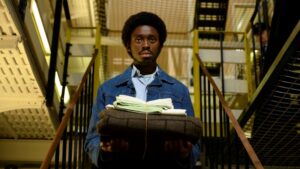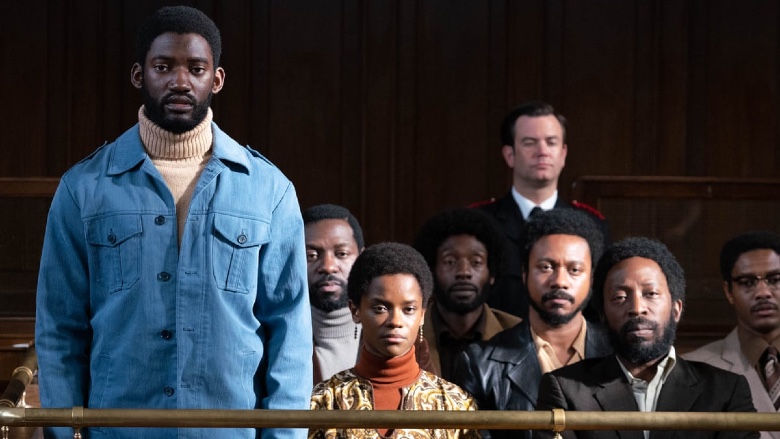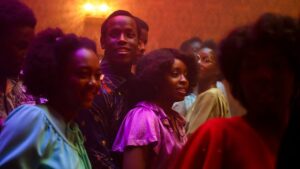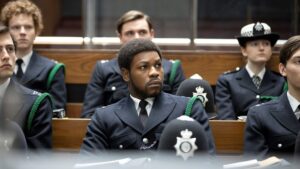
Created, co-written and directed by Steve McQueen (12 Years a Slave), Small Axe is an anthology series consisting of five individual stories with an emphasis on the West Indian immigrant community in London from the 1960s spanning through the 1980s. Initially, it was going to be six one-hour episodes for BBC One, and then it became five films. The five distinct films are Mangrove, Lovers Rock, Red, White and Blue, Alex Wheatle and Education with the visual look and design for all five led by Production Designer Helen Scott (A Very English Scandal, Baghdad Central). Scott’s range, time period evolution, authenticity, and creative design can be seen over the course of McQueen’s five films.
Scott explained the visual timeline for the series, “It was very much a London story, all of the stories are very London — London became the main arena. The look came from a lot of research about London at that time in the late 60s. It was very much a post-war look; the war damage was still very apparent and very slow to turn around, especially in the areas where the immigrant population or where the West Indian population lived, which were the last areas to be upgraded or gentrified. It was really born out of that, the wilderness parts of London, where people had to struggle living in very poor accommodations, being overcrowded, and lots of dereliction around them. That’s where things started and those developments over the next couple of decades into the early 80s. By the time we get to Leroy Logan’s story, it was more cleaned up. It also chimed quite well with the story in terms of it being about a police environment with regulation, an added organized feel about it, the repetition of windows on buildings, and the optimism of the late 60s and early 70s which fed into the 1980s. The looks for each episode were drawn from London at that time. The stories were full of character and color. There were lots of possibility, lots of references, and it was great fun researching it.”

The first film, Mangrove, is centered around the citizens involved with the Mangrove restaurant clashing with the harassment and brutality from the police. The production designer detailed, “In Mangrove, it started out as two episodes and became one film. We found the streets in London, tried to adapt and dress it to emulate All Saints Road. We took over that street, dressed each shop front, and did a lot of work in the streets, which included removing a tree. For the restaurant itself, we knocked a wall down between two shops internally, so that we have more space inside. There was quite a lot of construction work on that particular location because it was important to have the interior of the restaurant connect to the street and not to cheat between two different locations. It was really important that the outside pulley and the police could see into the restaurant and from the restaurant, we could walk out into the streets and it was all a believable place. The Mangrove restaurant was a hub because it was warm and West Indian. It was made to look very comfortable and inviting, somewhere that people could go and feel that they belonged. The Mangrove itself was an ordinary office with a window on the street. That was completely clad inside and redecorated with the floors and shop window being redone. It’s not a set build, but it is as good as the set build, just happens to be on location.”
Scott continued, “Then the homes, the places people lived, I was choosing wallpapers and furniture that were quite graphic. The patterns were tonally contrasting and the furniture was quite dark against paint. It was trying to get that graphic feel about it, black and white. The colors were vibrant, quite rich, and strong. I was trying to concentrate on the spoken word; the banners, posters, and the placards. I was looking at London as a backdrop for the written word. The colors I chose as a backdrop in the streets were quite dusty and pale papery colors. When they wrote a message or when there was graffiti, they stood out. We were using black and deep purple ink on paper. It was bleached out backgrounds and then a strong message on top of it in a very vibrant wet ink color. The backdrop of London was this war damage, colorless, before the corporate world, still a very much a handmade world. But then there were really powerful voices stirring within the buildings of Notting Hill. That’s what I was trying to do was to get the places inhabited, a sense of lifeblood, urgency, message, and pronouncements.”

The second film, Lovers Rock, is set around a house party with a dedication to relationships, music, and romance. “Then Lovers Rock, there was one very large house. I wanted it to feel cold and damp. When the party was going, to have a sense that it was echoing the sounds and maybe we got a sense of feeling like we’re inside one of the boomboxes. We got the sense that things might be vibrating, the windows are rattling, and there’s condensation everywhere. The whole episode really takes place in that house, it had to be big and be interesting. We had to get good shots, the stairs down to the kitchen, and relationship between the front door and the party room out onto the street. We were lucky to find that house because it had all of those elements, obviously we completely redecorated it,” the production designer described.
The third film spotlights the true-life journey of Leroy Logan (John Boyega) on becoming a police officer to impact and change their racist views. The police facility location is highly utilized in this one. “For the third one, Red, White and Blue, we relocated from London to the West Midlands at this point, although the story was still based in London. It was quite a distance away because we went to a place called Wolverhampton and the surrounding towns had a very distinct look; we can’t find those locations in London anymore with the 1960s and 1970s municipal buildings. They still have them there because it hasn’t really been overdeveloped yet. It gave us an opportunity to embrace that more brutalist and modernist architecture and to make that the world of the police. It was pure, clean, characterless, and municipal,” Scott said.

The fourth film, Alex Wheatle, explores the true story of Alex Wheatle from his childhood to his adult years. Alex’s environment gradually fluctuates from an institutional care facility to Brixton to prison. The production designer expanded, “The Alex Wheatle story, which was based in Brixton, gave us more of a chance to have a cacophony of color, culture, and noise. Not to constrain the designs as I did with the other ones. The other ones I was trying to select rules for myself really in terms of design. With Alex Wheatle, I was a bit freer because we knew we wanted to choose Brixton. We went for more clashy and poppy colors. Since it was the early 80s, we went slightly more neon and louder in the streets, so it’s more chaotic and noisier.”
The last film Education, concentrates on 12-year-old Kingsley (Kenyah Sandy) with the set mainly being the schools and the home. “For the last one Education, it was more a domestic drama and like social realism because it was back in the 1970s. It had its own small, little suburban world. The colors were much more conventional working class. I wanted to make that much paler from the others; more pastel, more conventional, and less exotic. Since they were trying to conform and fit it, it had a much more conventional English sensibility to it, it was much less colorful. The story is strong and the characters are also strong in each story,” Scott revealed. “I really try to get to the core of the story for each episode and try to interpret that in a visual way.”
The entire Small Axe Anthology can be watched on Amazon Prime Video.
All photos courtesy BBC and Amazon Studios.





